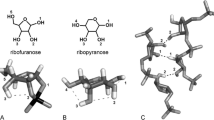Abstract.
Ribonucleotide reductases (RNRs) catalyse the reduction of ribonucleotides to deoxyribonucleotides. They play a pivotal role in the regulation of DNA synthesis and are targets for antiproliferative drugs. Ribonucleotide reductases are unique enzymes in that they all require a protein radical for activity. Class I nonheme iron RNRs (mammals, plants, Escherichia coli) use a tyrosyl/cysteinyl radical pair, class II adenosylcobalamin RNRs (prokaryotes, archaea) a cysteinyl radical, class III iron-sulphur RNRs (facultative anaerobes) a glycyl radical. Here we describe the reactivity of these radicals with respect to the natural ribonucleotide substrates as well as to a variety of enzyme inhibitors, radical scavengers, nitric oxide, superoxide radicals and substrate analogues.
Similar content being viewed by others
Author information
Authors and Affiliations
Additional information
Received 3 December 1997; received after revision 26 February 1998; accepted 27 February 1998
Rights and permissions
About this article
Cite this article
Fontecave, M. Ribonucleotide reductases and radical reactions. CMLS, Cell. Mol. Life Sci. 54, 684–695 (1998). https://doi.org/10.1007/s000180050195
Issue Date:
DOI: https://doi.org/10.1007/s000180050195




